

ASTEROID I N STI TUT E
A PROGRAM OF B612

Cover: Sun glinting off the Pacific Ocean, by Ed Lu from the ISS
This page: The Great Barrier Reef, by Ed Lu from the ISS

Launched in 2017, the Asteroid Institute is a program of B612 and is designed to be the international center of excellence for scientific collaboration on the discovery and deflection of asteroids as well as an incubator for new technologies. This report outlines progress on science and research within the Asteroid Institute and other public education programs at B612.
LETTER FROM THE PRESIDENT

What a year it has been! Humanity has been plagued by a global health pandemic, turbulent social times, and, on the flip side, we have had interesting celestial headlines including cool comets, a couple of close asteroid fly-bys, and several exciting asteroid missions to inspire our imaginations.
In reflection, one thing we’ve learned from the COVID-19 crisis is the importance of taking the long view. A global pandemic was an inevitability. History has shown us it happens. In the same sense, an asteroid impacting the Earth is also an inevitability. We do not want to be caught off-guard. And we don’t have to be. Data is one of the most powerful tools we have today. It is vitally important to take the long view on risks and invest in tools and technology to help predict, interpret, and understand the future. At the Asteroid Institute, we are working to study and understand asteroid risks, develop strategies to reduce the risks, and foster a global community of academics, technologists, and policymakers. Our primary goal is safeguarding humanity from this preventable existential risk while building a space map to enable the exploration of our solar system.
With thanks to the generosity of our donor community, we expanded our Asteroid Institute research and engineering team with the addition of Carise Fernandez, who joined us as our Senior Software Engineer, and Kathleen Kiker, also a software engineer. In addition, we’ve gained the expertise of several new and talented engineering and research collaborators. You can read more about them in the pages that follow.
With Carise’s leadership and our new collaborators, we’ve been able to make exciting progress on our Asteroid Decision Analysis and Mapping (ADAM) project, including advancing ADAM’s platform and infrastructure and producing real-time visualizations from a set of synthetic, or “fake,” asteroids (and even a few real ones). We also continue the support of high level scientific research out of the Asteroid Institute. In particular, Joachim Moeyens, an Institute collaborator at the University of Washington, recently published his research on the Vera Rubin Observatory (formerly named LSST) Moving Object Pipeline System (MOPS). This is the software designed to link millions of moving object (aka asteroid) detections into realistic and time-forward predictable orbits. His research gives the community a roadmap on how to react to potential impactors
discovered. Joachim’s research, and how it will drive parts of the ADAM platform, is described later in this report.
A major part of our programming has always been public education. Given COVID-19, we had to pivot quickly and launch a virtual events program. We kicked things off this spring with a light-hearted “Ask Me Anything: Stump the Astronaut” with Ed. We have since headlined at several public and private audiences in partnership with The Explorers Club, SETI, Salesforce, the Rotary Club of Santa Barbara, and several other schools and organizations.
This world has got many reasons to close our minds and lock them in, and I hope Asteroid Day will open minds.
PETER GABRIEL, MUSICIAN AND ACTIVIST
And, finally, on June 30th, individuals, astronomy groups, schools, museums, and organizations from around the world came together, looked up to the sky, and then shifted their gaze onto computer screens to celebrate a virtual Asteroid Day. B612 is a founding partner and continuing sponsor of Asteroid Day and we were proud to support the evolution of this year’s programming. Asteroid Day programming and events are described in more detail in this report.
As we moved through the turbulence of this year, and perhaps for years to come, we will continue to take the long view and will work tirelessly to develop tools and technologies to protect our home planet from the inevitability of Earth-impacting asteroids. Our work is dependent upon the support and trust of our science and technology collaborators and donor community. We look forward to taking you, our crew, along for this exciting journey into the future.
Looking ahead,

Danica Remy President, B612 Foundation Co-Founder, Asteroid Day
ABOUT US
B612 is dedicated to protecting Earth from asteroid impacts. We do this through:
ASTEROID I N STI TUTE
ASTEROID EDUCATION
Driving forward science and technologies needed to protect Earth from asteroid impacts through the Asteroid Institute.
Educating the public, the scientific community, and world governments about asteroids through programs such as Asteroid Day.
Since the organization’s inception in 2002, our work has been carried out entirely through the support of private donors.
What started in 2002 as a visionary idea to develop the technology to deflect an asteroid has grown into a world-renowned organization and scientific institute with a key role in the emerging field of planetary defense. For years, B612, our partners, and a global community of dedicated scientists and researchers have advocated for increased asteroid detection, and many victories have resulted from those efforts. Asteroid detection is now debated seriously in scientific, governmental, and public conversations.

Rivers in Paraguay, by Ed Lu from the ISS
IN THE LAST YEAR
Asteroid Institute Grows Engineering Team
This year the Asteroid Institute expanded its engineering team with the hire of former Google software engineer Carise Fernandez. Carise leads the infrastructure development of ADAM and expanded her team with the hire of software engineer Kathleen Kiker.
ADAM Demo of an Asteroid Orbit
We demonstrated that by using ADAM, we can propagate millions of orbits centered around a single trajectory of an asteroid. This demo showed a proof-of-concept method for determining the probability of an Earthimpacting asteroid. This is a step toward integration with LSST, where ADAM will be used to determine the impact probability of many thousands of objects. You can find several articles on our website that include links to these demonstrations.
Research Published Out of the Asteroid Institute
We need to develop a widespread understanding about asteroid risks in order to minimize the likelihood of the politicization or discarding of experts around the issue.
Asteroid Institute Researcher Dr. Sarah Greenstreet’s paper “Required deflection impulses as a function of time before impact for Earth-impacting asteroids” was published in the journal Icarus. This research looks at (synthetic, or “fake”) asteroids on an impact trajectory and how the amount of time prior to impact a deflection can drastically change the amount of deflection impulse required. A digital copy of this research is available on our website.
RUSTY SCHWEICKART, B612 CO-FOUNDER
B612 Sponsors LSST Solar System Readiness Sprint
For the third consecutive year, B612 sponsored the Solar System Readiness Sprint, a convening of scientists ensuring the readiness of the scientific community to use and interpret Vera Rubin Observatory (formerly named LSST) solar system data when it begins operation. In preparation for this data, the scientific community is collaborating, collecting resources, and building analytical tools, including the Asteroid Institute’s ADAM project.
ASTEROID I N STI TUTE
LETTER FROM THE EXECUTIVE DIRECTOR

This year the Asteroid Institute continued to advance the science and technologies to discover, track, and calculate the trajectories of asteroids. We have made great strides with the Institute’s priority project, the Asteroid Decision Analysis and Mapping, or ADAM, project. When the Vera Rubin Observatory (formerly named the LSST) goes online in 2022 (but likely delayed until 2023 due to COVID-19 impacts), it will become the world’s largest astronomical allsky survey telescope and will increase the discovery rate of near-Earth Asteroids by an order of magnitude. Now is when we must develop broadly accessible, transparent, and open-source computational tools to calculate and understand asteroid orbits, and this is what we are building with ADAM.
ADAM is an open-source cloud-based platform for asteroid data analysis and mapping and will form the basis for a space map of the solar system. This space map will inform future services such as mission planning, asteroid-risk visualization, space navigation, and resource mapping.
Through the generosity of several major supporters and donors from around the world, we were able to hire Carise Fernandez as the Asteroid Institute’s Senior Engineer. Carise is leading the infrastructure development of ADAM and has already made significant contributions to advancing ADAM. Recently we demonstrated ADAM’s ability to rapidly propagate hundreds of thousands of orbits representing the possible trajectories of an asteroid. These so-called Monte Carlo runs are used to understand the variability in potential outcomes given the uncertainty in the position and velocity of an asteroid. This new functionality is one of many steps toward data integration with Vera Rubin Observatory data.
In addition to ADAM, we continue our research and development of the use of synthetic tracking as a means to increase asteroid discovery rates. We have advanced our capability to operate high-performance computing hardware for use in highradiation environments like space. Rather than using expensive and low-performing radiation-hardened processors, we are adapting a commercially available and relatively inexpensive state-of-the-art system on a chip ( SoC) for use in high-radiation environments. We will share more about this work in the future.
To our future,

Dr. Ed Lu
Executive Director, Asteroid Institute
NEAR-EARTH ASTEROID SIZE RANGES & TRACKING
More than 99% of the asteroids large enough to destroy a city (like the Tunguska asteroid) remain untracked.
NEAR-EARTH ASTEROID SIZE RANGES
Chelyabinsk, 2013
19 m (62 ft)
More than 30 A-bombs
There are 2.5 million near-Earth asteroids in this size range.
Tunguska, 1908
45 m (148 ft)
More than 400 A-bombs CITY KILLER
140 m (459 ft)
More than 7,000 A-bom bs NASA GOAL
There are 500,000 near-Earth asteroids in this size range.
More than 150,000 A-bombs CIVILIZATION ENDER
There are 25,000 near-Earth asteroids in this size range.
LSST & NEOSM 2008–2030 (EST. COMPLETION)
There are 1,000 near-Earth asteroids in this size range.
SPACEGUARD SURVEY 1998–2010 (COMPLETED)
ASTEROIDS TRACKED
As of October 1, 2020, the Minor Planet Center has 23,932 near-Earth Asteroids in its database. This year, 2084 new NEAs were discovered, largely by Pan-STARRS and Catalina Sky Surveys.
ASTEROID I N STI TUTE
FROM OBSERVATIONS TO IMPACT PROBABILITIES
By Joachim Moeyens
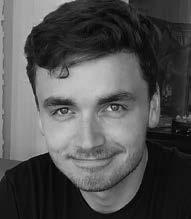
One of our main research goals is understanding how, upon discovery and subsequent observation, the probability of impact for potential impactors evolves over time. Understanding how impact probability will change as we improve our understanding of an impactor’s orbit is vital in determining what mitigation strategies may be available to us to prevent a future impact.
To conduct our study, we are using a simulated population of 10,000 Earth-impacting orbits with varying diameters yielding some 70,000 potential (and, thankfully, synthetic!) impactors. We then simulate the performance of the Legacy Survey of Space and Time, an astronomical survey to be conducted at the Vera C. Rubin Observatory starting in 2022 (but likely delayed until 2023 due to COVID-19 impacts), over the course of the impact span of our impactors (100+ years of observations and 50+ million observations!). Each time a new observation is made, our software computes a new orbit, then, taking the uncertainty region around that orbit, propagates thousands of orbit variants forward in time to understand how many may impact the Earth in the future. This is done for each impactor every time a new observation is made, meaning hundreds of millions of orbit propagations need to be executed. A study of this size and magnitude can be conducted only by cloudaccelerated platforms. ADAM provides the architecture, the tools, and the computing capacity that enable this study to be conducted.
A significant achievement in the last year has been the development of an end-to-end pipeline that allows us to go from observations to impact probabilities, using ADAM and a Python-based pipeline we developed. This system is being validated at present— we are working to understand and reconcile differences in results given by different computation techniques and different ways to calculate impact probability: whether it’s exactly where an impact may occur on Earth (within a few miles), or when (within a few seconds), or the probability of the impact itself. Though observed differences can seem small, they have to be fully understood and accounted for given the importance of accuracy in planetary defense. Our pipeline is already useful to scientists studying the solar system and, as with everything we do, we will make the results of this study publicly available, easy to interpret, and, above all, reproducible.
About Joachim
Joachim is an Asteroid Institute Researcher and graduate student in the Department of Astronomy at the University of Washington. Joachim is interested in big data and software-driven solutions to problems in astronomy. During his undergraduate studies at the University of Washington, he was presented with the opportunity to work on a research project for the Vera Rubin Observatory’s Legacy Survey of Space and Time (LSST). For his doctoral thesis, Joachim is working on algorithms that discover minor planets in astronomical surveys, in particular, on Rubin Observatory’s Solar System Processing pipelines, and on a novel algorithm named Tracklet-less Heliocentric Orbit Recovery (THOR).

Sahara Desert, Algeria, by Ed Lu from the ISS
ASTEROID I N STI TUTE
ADAM MODELING ASTEROID 2018 VP1
While 2020 handed out plenty of things to worry about, Asteroid 2018 VP1 hitting Earth on November 2nd isn’t one of them. You might recall the sensationalist headlines of a potential Earth-impacting asteroid heading our way on November 2, the day before the United States presidential election. We don’t understand what makes a story go viral like this, but it certainly was not because this event poses a real risk. Asteroid 2018 VP1 has less than a 1% chance of hitting Earth’s atmosphere, but even if it does hit, it will disintegrate in the atmosphere and simply be an interesting fireball in the sky.
Here are the facts:
• Asteroid 2018 VP1 is quite small at only about 6 feet.
• The probability of impact with Earth is about 0.4%.
• Even if it hits the atmosphere, it will just be a bright meteor in the sky.
• Analysis of this asteroid’s trajectory is based on only 21 observations spanning just under 13 days (from November 2, 2018–November 16, 2018). The fact that there are relatively few observations of 2018 VP1 means there is considerable uncertainty in the orbit, which means the best we can say right now is that the asteroid will likely pass Earth somewhere between a few thousand miles from Earth and a few hundred thousand miles from Earth. In other words, it may not even come close!
• While asteroid 2018 VP1 poses no risk to Earth at all, it is a good example that illustrates how asteroids that are tracked for only a short period have considerable uncertainty in their orbits. Had this been a very much larger asteroid, this conversation could be quite different.
The ADAM project is made possible through major gifts from three anonymous major donors, William K. Bowes Jr. Foundation, Steve Jurvetson, and Tito’s Handmade Vodka, in addition to donors from over 46 countries around the world.

The small Asteroid 2018 VP1 will be passing close by Earth on November 2, 2020, with a small chance of hitting Earth (just 0.4%) somewhere along the red line picture above. This asteroid is only about 6 feet in size, so an impact means nothing more than a bright fireball in the sky. In the far likelier case of the asteroid flying past Earth on November 2, the variation in possible trajectories spreads out after passing by Earth (the green lines in the image below).
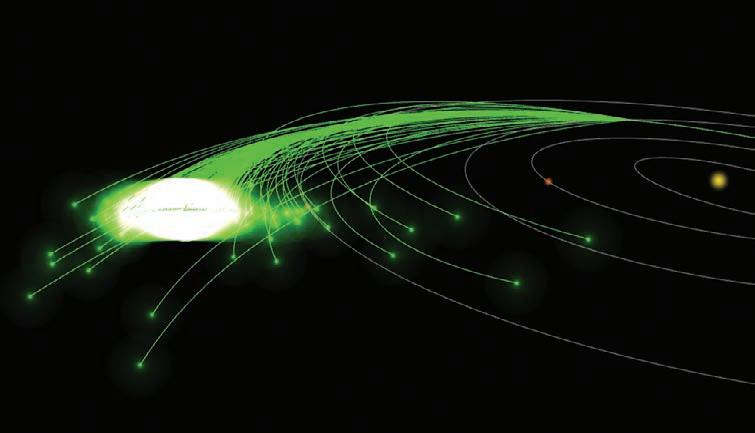
PROGRAM EVOLUTION
2002
B612 founded with the goal of significantly altering the orbit of an asteroid in a controlled manner.
2004–2008
B612 leads the Apophis debate.
2005
B612 announces the invention of the gravity tractor in Nature
2008–2009
B612 funds design study at JPL showing feasibility of the gravity tractor.
2012–2013
Open letter sent to NASA about deflection mission planning and discussions regarding potential impact of asteroid 2011 AG5.
B612 announces the Sentinel Space Telescope project.
Sentinel project passes its first major technical review.
2014–2015
B612 releases asteroid impact video with data from the Nuclear Test Ban Treaty Organization.
B612 is Founding Sponsor of Asteroid Day, a global asteroid-awareness campaign.
B612’s “Sentinel to Find 500,000 Near-Earth Asteroids,” published in IEEE Spectrum
B612 hosts Bay Area Asteroid Day event with California Academy of Sciences.
Asteroid Day project holds 150 events worldwide.
B612 funds Caltech research study to validate synthetic tracking feasibility.
2016 NASA announces Planetary Defense Coordination Office.
Asteroid Day is recognized by the United Nations and holds 500 events worldwide.
B612 begins Asteroid Decision Analysis and Mapping project (ADAM) to improve the ability to make decisions on potential asteroid threats.
B612 endorses NEOCam and LSST for 100 m+ solution and stops fundraising for Sentinel project.
2005
Congress gives NASA the goal of finding 90 percent of asteroids larger than 140 meters, called the George E. Brown Jr. Act.
2006
United Nations ASE NEO Committee initiated.
GRAVITY TRACTOR
2012–2013
A 19 m meteor exploded over Chelyabinsk, Russia, injuring over 1,500 people and damaging thousands of buildings across six cities.
UN Committee on Peaceful Uses of Outer Space and General Assembly pass resolution creating International Asteroid Warning Network.
Construction project for Large Synoptic Survey Telescope (LSST) begins.
NASA announces Planetary Defense Coordination Office.
OSIRIS-REx mission to asteroid Bennu launches.
2017
B612 launches the Asteroid Institute.
Asteroid Institute builds team for ADAM to provide analytical tools for asteroid defense scenarios.
Asteroid Day moves to Luxembourg and streams a 24-hour global broadcast.
B612 publishes call for shared solar system map in Financial Times
B612 Foundation celebrates 15th anniversary.
2018
Asteroid Institute announces Google and AGI as ADAM technology partners.
Asteroid Institute announces appointment of Senior Research Fellows.
On Asteroid Day, 2,000+ events held worldwide, streams a 48-hour global broadcast.
Asteroid Institute publishes synthetic tracking results as a NASA technical report.
2019
Final report on Sentinel’s infrared technology research and new synthetic tracking shared with the National Academy of Sciences.
Asteroid Institute research on deflection impulses to move asteroids presented at Planetary Defense Conference.
Asteroid Day celebrates 5th anniversary and streams 21day global broadcast.
ADAM Engineer Funding campaign launched.
2020
ADAM demo of an asteroid orbit propagation shared with B612 insiders.
Asteroid Institute Researcher
Dr. Sarah Greenstreet’s paper “Required deflection impulses as a function of time before impact for Earth-impacting asteroids” published in the journal Icarus
Asteroid Institute hosts ADAM hackathons (virtual in 2020).
Asteroid Day goes virtual and broadcasts 30 days of Asteroid Day TV.
ADAM engineering team hired.
Asteroid Impact and Deflection Assessment (AIDA) almost funded by EU and USA.
DART (Double Asteroid Redirection Test) is funded.
SYNTHETIC TRACKING
ASTEROID DAY
ASTEROID DECISION ANALYSIS AND MAPPING (ADAM)
Pew Research poll shows Americans believe asteroid monitoring should be national priority.
United Nations OOSA publishes Planetary Defence Report.
The Hayabusa2 spacecraft surveyed the asteroid Ryugu.
Associated Press research shows Americans believe asteroid monitoring should be a national priority.
ESA’s Hera mission funded.
LSST changes its name to the Vera C. Rubin Observatory.
COVID-19 quarantines the world, reminding us of the importance of taking the long view.
Hayabusa2 collects asteroid Ryugu samples and heads back to Earth.
OSIRIS-REx collects a sample of asteroid Bennu.
ASTEROID I N STI TUTE
RESEARCHERS & COLLABORATORS *
Carise Fernandez, ADAM Senior Software Engineer BS, UC Berkeley, Electrical Engineering and Computer Science
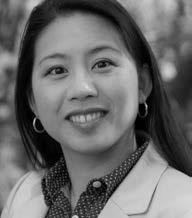
Carise is the Lead Software Engineer at B612, bringing experience in cloud engineering to ADAM. She is driving efforts to build ADAM’s infrastructure. Carise was formerly a software engineer at Google, developing a security product in the Google Cloud Platform to detect malicious activity in real time. Prior to B612 and Google, Carise led product development in several startups in agriculture, clean-tech, and e-commerce.
John Carrico, ADAM Program Manager and Institute Astrodynamicist BS, Michigan State University, Physics

John is the ADAM Program Manager and Institute Astrodynamicist. He designs and develops mission planning algorithms and software. John has supported several operational Earth and lunar spacecraft missions and has designed and written trajectory design algorithms and software used for mission analysis and spacecraft operations ranging from Earth to interplanetary.
Kathleen Kiker, ADAM Software Engineer
MS,
George Mason University, Physics

Kathleen is an ADAM software engineer. Her prior research focused on Black Hole formation using Cloudy simulation software. She is skilled in a range of programming, modelling, and graphing tools to solve physics problems. Previously at Lockheed Martin, she led the development for the latest releases of a large-scale Fortran and C++ physics modelling code to run on high performance computers (HPC).
Dr. Lynne Jones, Asteroid Institute Collaborator
PhD, University of Michigan, Astronomy and Astrophysics

Lynne is the Performance Scientist for the Vera Rubin Observatory’s Legacy Survey of Space and Time (LSST) at the University of Washington and co-chair of the LSST Solar System Science Collaboration. As part of her work with LSST, Dr. Jones evaluates the scientific performance of LSST observing strategies, including the potential for studying small bodies with this next-generation telescope.
Dr. Siegfried Eggl, Institute Collaborator
PhD, University of Vienna, Astronomy and Astrophysics
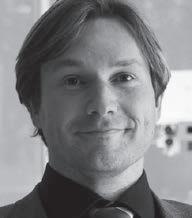
Siegfried is a research scientist at the University of Washington. Dr. Eggl’s research focuses on the habitability of terrestrial planets in binary star systems. He previously worked as a post-doctoral researcher at the Institut de Mécanique Céleste et de Calcul des Ephémérides in planetary defense. In 2016, Dr. Eggl worked at the NASA Jet Propulsion Laboratory and is now a research scientist at the University of Washington.
Emmie King, ADAM Software Engineer
BS, Univ. of Maryland College Park, Aerospace Engineering
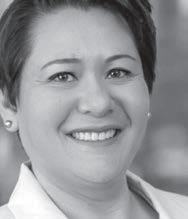
Emmie is a software engineer with Space Exploration Engineering (SEE) and works to understand desired application capabilities and testing scenarios. She designs, develops, tests, implements, and supports technical solutions to development tools and technologies. She also contributes code to the development of multiplatform application systems.
*This list does not represent all of the Researchers and Collaborators at the Asteroid Institute.
ASTEROID I N STI TUTE
CHARTING THE HIGH FRONTIER OF SPACE
By Dr. Edward Lu and Richard Carty
Abstract: This is a summary of a longer paper that sets out the need, value, and opportunities for a dynamic map of our solar system. This map will be served up by the engine the Asteroid Institute is building called the Asteroid Decision Analysis and Mapping (ADAM) project.
The opening of frontiers has historically been enabled by the creation of maps. The building of comprehensive maps showing the location of geographic features, resources, and trade routes has throughout the ages been the key to defense, economic expansion, and scientific discovery. A shorthand notation for these goals could be distilled to the primal motives of fear, greed, and curiosity. With these catalysts, humans have applied the principles of cartography as essential tools for expansion beyond our boundaries. We believe the mapping of the solar system will play a similar enabling role in the eventual opening of the space frontier.
So what does it mean to chart the high frontier? The crucial additional element for mapping objects in space as opposed to the traditional requirements of mapping the surface of a planet like Earth is that we must take into account that celestial bodies in space are continuously moving in three dimensions. Like floating islands in an everchanging archipelago on a sea, the celestial bodies in our solar system circulate around the Sun obeying the laws of celestial mechanics. On solar system–length scales, this additional element of mapping trajectories in space is the most critical. The most important aspect of identifying and navigating to celestial bodies is knowing where the body is and where it is going. The fundamental base layer on which a solar system map will be built is this location and trajectory information.
One can think of this solar system map as a four-dimensional (three spatial dimensions plus time) rendering of locations and velocities of the celestial bodies in our solar system. The time dimension can be specified so that these locations and velocities are depicted either at the present, times in the past, or, most importantly, at times in the future. The predictive nature of this map is possible because we understand the laws of celestial mechanics under which trajectories of bodies in space move under the influence of gravity (with some small contribution from other non-gravitational effects). The more accurately we know the current orbital state of a body, the further
we can accurately project where it will be located in the future. At present, for welltracked solar system bodies, we can reliably predict their motion about a century into the future. Having this predictive ability is crucial because space missions generally take months to years to reach their destinations, and planning begins even years before that. That means we must target not where our destination is now, but where it will be at the time we arrive, perhaps years in the future.
The inner solar system is comprised of four planets (Mercury, Venus, Earth, and Mars) and their respective moons, plus millions of asteroids ranging in size from smaller than a house up to hundreds of kilometers across. Many of these asteroids reside in the asteroid belt, at the outer edge of the inner solar system between Mars and Jupiter, orbiting the Sun at a distance roughly three times farther than does Earth. Because their orbits are confined between Mars and Jupiter, these main-belt asteroids never approach Earth closer than about a hundred million miles, and they are therefore relatively less accessible from Earth than objects closer to the Sun.
There is, however, another class of asteroids not in the asteroid belt called nearEarth asteroids (or NEAs), which orbit the Sun at distances similar to the Earth, and which therefore occasionally come very close to Earth, even occasionally colliding with Earth. These are our nearest cosmic neighbors, and from the standpoint of the development of space, they are the most relevant. They are the most lucrative because of their accessibility, the most threatening because of their impact risk, and the most scientifically interesting, as they are the easiest scientific mission targets.
A comprehensive predictive map of the locations and trajectories of near-Earth asteroids would tell us well in advance of impending asteroid impacts, allowing us ample time to deflect asteroids away from Earth. Such a comprehensive map could also serve as the basis for future commerce in space, both as a means of identifying and claiming outer space resources and as a fundamental navigational layer upon which space location–based services can be built. Finally, the distribution of asteroid orbits represented by the map will be a treasure trove of information on the history and evolution of our solar system, and it will also provide the means of identifying fruitful targets for scientific missions. Once again, our primal motivations of fear, greed, and curiosity compel us to pay heed to these frontier objects, and, once again, our initial need is to map them.
ASTEROID EDUCAT ION
ASTEROID DAY GLOBAL
On June 30th, individuals, astronomy groups, schools, museums, and organizations from around the world came together, looked into the skies, and then shifted their gaze onto computer screens to celebrate a virtual Asteroid Day. In years past, Asteroid Day brought asteroid experts, notables, and space agencies leaders together in Luxembourg for a live broadcast. Due to the COVID pandemic this year, Asteroid Day embarked on a new journey and hosted their Asteroid Day LIVE program from living rooms and offices around the world. In addition, Asteroid Day TV, a broadcast of asteroid education programming, ran for 34 days leading up to Asteroid Day. B612 is a founding partner and continuing sponsor of Asteroid Day and we were proud to support the evolution of this year’s programming.

As the first and earliest founding partner of Asteroid Day, we are pleased to see Asteroid Day’s increased global reach year over year and particularly this year. The combined press and social media reach measured through Talkwalker was over nine billion. And the Asteroid Day LIVE Digital program was watched by more than two million people on Twitch.tv between 29 June and 1 July in addition to viewers tuning in via SES satellites, which they cannot measure.
And, finally, independently organized events ranged from live webinars to virtual story contests in Austria, Brazil, Canada, Chile, Colombia, Cyprus, Greece, India, Israel, Italy, Jordan, Mexico, Nigeria, South Africa, Spain, the United Kingdom, the United States, and the United Arab Emirates, to name just a few. Hundreds of these virtual events, in dozens of languages, were hosted in the days leading up to Asteroid Day and continued in the weeks post Asteroid Day.

Left to right, pre-COVID: Hillary Aiken, B612 Vice President; Rusty Schweickart, Apollo 9 astronaut, B612 and Asteroid Day co-founder; Peter Gabriel, musician, activist, and Asteroid Day supporter; and Danica Remy, B612 President and Asteroid Day co-founder.
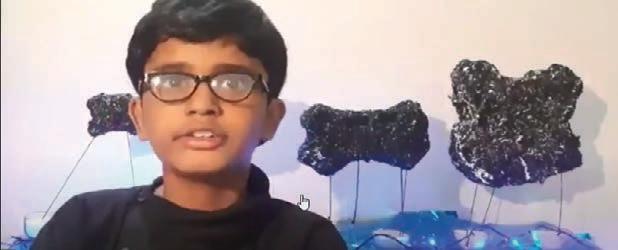

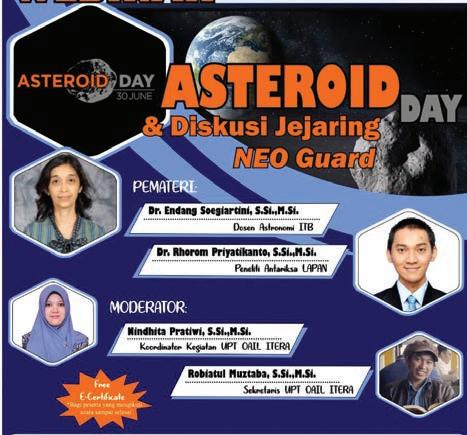






ASTEROID EDUCATION
Our Asteroid Education program increases awareness about asteroids and science through public speaking and exposure in the media. In addition to Asteroid Day, this year we shared stories about our work and why the world should learn more about asteroids. We have highlighted just a few public education activities from this past year.
Rusty Schweickart
SPACECONNECTS.US
In response to the COVID-19 quarantine, astronauts and notables from around the world gathered virtually to speak about their experiences in confined places, what space may provide to help, their trust in science, and the sources of their inspiration.

March
Dr. Ed Lu
CHARTING THE HIGH FRONTIER OF SPACE WITH THE EXPLORERS CLUB TALK
In an effort to engage a global virtual audience, Ed presented the case for a fourdimensional map of the solar system in his talk titled “Charting the High Frontier of Space.”

April
Dr. Ed Lu
STUMP THE ASTRONAUT, ASK ED ANYTHING!
Kicking off this year’s virtual event series, we invited the global “B612 Crew” to “Ask Dr. Ed Lu Anything.” It was great to see B612 supporters, families, and children from around the world on the small screen. Ed answered questions about what asteroids are made of, asteroid deflection options, whether or not anyone has done ballet in Space, and his favorite food on the International Space Station.
May
INTERNATIONAL ASTEROID DAY
Asteroid Day LIVE Digital programming was watched by more than two million people on Twitch.tv between 29 June and 1 July in addition to viewers tuning in via SES satellites.

June
Dr. Ed Lu
ASTEROID DAY TALK WITH SETI
Moderated by SETI Institute Senior Director of Education and STEM Programs Simon Steel, Ed discussed the role of B612 in planetary defense at large, including protecting the planet, but also informing and forwarding worldwide decision-making.

Dr. Ed Lu, Danica Remy GETTING THE FACTS RIGHT ABOUT THE ELECTION DAY ASTEROID IN SALON
With asteroid 2018 VP1 making headlines in late August, Ed Lu and Danica Remy spoke to Salon about the unlikelihood of this asteroid hitting Earth and how the tools the Asteroid Institute is building can help determine risk.
August
Dr. Ed Lu
PUBLIC LECTURE HOSTED BY THE ROTARY CLUBS OF THE SOUTH COAST
Ed presented as the first featured speaker of the Spark! lecture series. Spark! is a joint public education and virtual lecture event hosted by the Rotary Clubs of the South Coast of California.


FOUNDING CIRCLE
ANONYMOUS x 7
ANONYMOUS LEADERSHIP GIFT x 3*
Bill Anders
Geoffrey Baehr
William K. Bowes Jr. Foundation
Brian Burton and James Mercer, Broken Bells
Don Carlson
Vinton and Sigrid Cerf
Y (Imc) Chapman
Emily and David Corrigan
Asa Denton
Esther Dyson
Alan Eustace
Sasha Galitsky
Eliot Gillum
Glaser Progress Foundation
Dane Glasgow
Steve and Julie Grimm
Garrett Gruener and Amy Slater
VK Hsu & Sons Foundation Ltd.
James D. and Justin Jameson
Margaret Jonsson Family Foundation
Steve Jurvetson*
Dominik Kaiser
Steve Krausz
Vladas Lašas
James Leszczenski
David Liddle and Ruthann Quindlen
Suzanna Mak
Greg McAdoo
Scott McGregor and Laurie Girand

ASTEROID CIRCLE
Matt Mullenweg
Diane Murphy
Peter Norvig
Shervin Pishevar
Peggy Rawls Family Fund
Ray Rothrock
Edwin Sahakian
Rusty Schweickart and Nancy Ramsey
Tim Trueman
Robert C. and Fallon B. Vaughn
Ben Wheeler
Yishan Wong and Kimberly Algeri-Wong
Rick Armstrong
Barringer Crater Company
Jim Chervenak
Lynn and Anisya Fritz
Arthur Gleckler and Kristine Kelly
Jensen Huang
Tito’s Handmade Vodka
*Leadership Gift ($1 M–$5 M)
Pictured at Meteor Crater in Arizona, May 2019
Top row (left to right): Zarik Boghossian, Rusty Schweickart, Ed Lu, Dana Stalder, John Kobs, Hillary Aiken, Diane Murphy, Lee Smith, Chuck Brady, Neil Everett, Jeff Beal
Bottom row (left to right): David Nosarti, Edwin Sahakian, Lynn Fritz, Ping Fu, Sarah Everett
We have donors from 46 countries.
COMMUNITY OF SUPPORTERS
Gifts $500–$24,999*
ANONYMOUS
Bill and Valerie Anders
Anne Arlinghaus
Rick Armstrong
Richard Bowen
Don Carlson
Daniel Ceperley
Y and Clark Chapman
Jim Chervenak
John Clendenin
Bob and Angela Coe
John Conery
Janine Cornecelli
Al Ender
Joseph Fischer
Arthur Gleckler and Kristine Kelly
Garrett Gruener and Amy Slater
Keith Hughes
John and Jenna Kobs
Sam Lichtenstein
Carol MacCorkle
Mike Meek
J. Menges
Richard and Susanna Nash
Drummond Pike
Dirk Pranke
Christian Principi
Nancy Ramsey and Rusty Schweickart
Martha Reynolds
David and Abby Rumsey
Eric Ryan
Edwin Sahakian
Scott and Nola Schneider
Joshua Slocum
Rick Stawicki
Eric and Stephanie Tilenius
Tim Trueman
Hal Varian
Al and Kathryn Werner
*From September 1, 2019, to October 1, 2020
Saipan and Tinian, by Ed Lu from the ISS

GOVERNING BOARD
Dr. David Liddle, Chair
Geoffrey Baehr
Dr. Clark Chapman
Dr. Dan Durda
Garrett Gruener
Dr. Ed Lu, Co-Founder
Danica Remy, President
Lawrence Wilkinson
ASTEROID INSTITUTE, A PROGRAM OF B612
Dr. Ed Lu, Executive Director
Dr. Marc Buie, Mission Scientist
Jonny Dyer, Spacecraft Systems Engineer
Dr. Scott Hubbard, Mission Strategist
Dr. Roger Linfield, Mission Analyst
Dr. Harold Reitsema, Mission Director
Jeff Rothermel, Avionics Engineer
Dr. Sam Waldman, Avionics Engineer
ADAM PROJECT TEAM
John Carrico, Project Manager and Astrodynamicist
Dr. Siegfried Eggl, Research Collaborator
Carise Fernandez, Senior Engineer
Hank Grabowski, Engineer and Astrodynamicist
Dr. Sarah Greenstreet, Senior Researcher
Dean Hawes, Technical Program Manager
Dr. Mario Juric, Research Collaborator
Kathleen Kiker, Software Engineer
Emmie King, Software Engineer
Dr. Tatiana Kichkaylo, Software Engineer
Laura Lark, Software Engineer
Mike Loucks, Astrodynamicist
Joachim Moeyens, Research Collaborator
Samira Motiwala, Astrodynamicist
Allan Posner, Engineer and Astrodynamicist
Dr. Vivek Vittaldev, Mission Researcher
B612 FOUNDATION
Danica Remy, President
Hillary Aiken, Vice President
Joelle Byars, Writer & Operations
Alex Shwe, Operations
ASTEROID DAY TEAM
Dr. Brian May, Co-Founder, United Kingdom
Danica Remy, Co-Founder, California, USA
Grig Richters, Co-Founder, Germany
Rusty Schweickart, Co-Founder, California, USA
Max Alexander, Photographer, United Kingdom
Stuart Clark, Editorial Director, United Kingdom
Colleen Fiaschetti, Program Director, Luxembourg
Saulo Machado, Global Event Coordinator, Brazil
Katie Young, Communications, Colorado, USA
